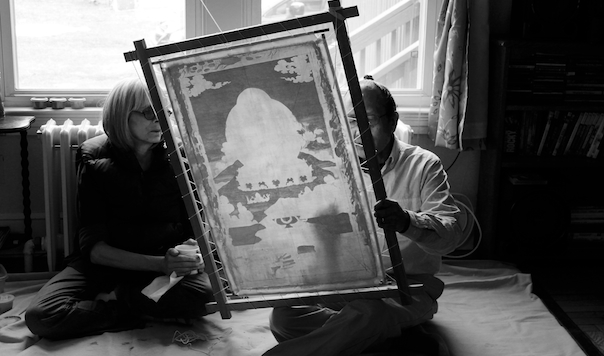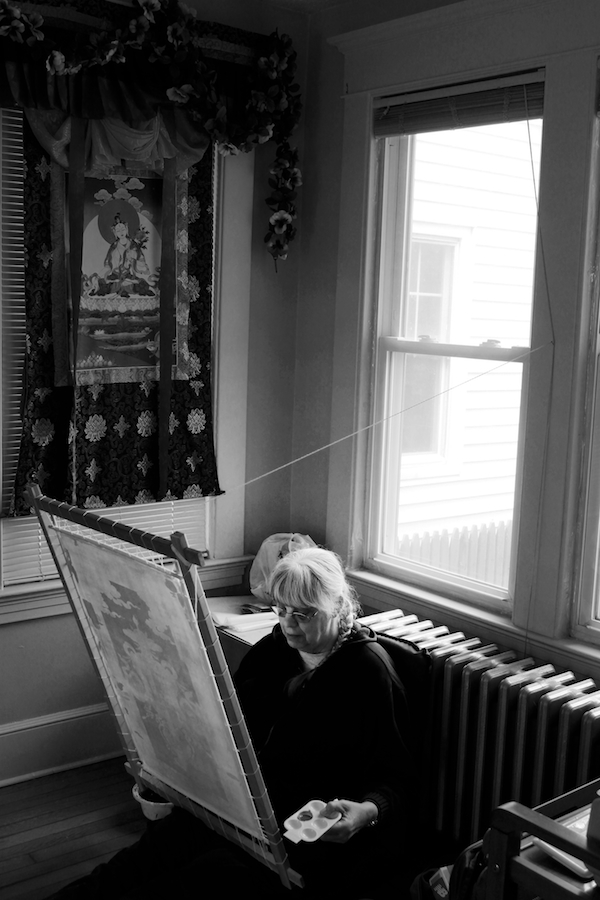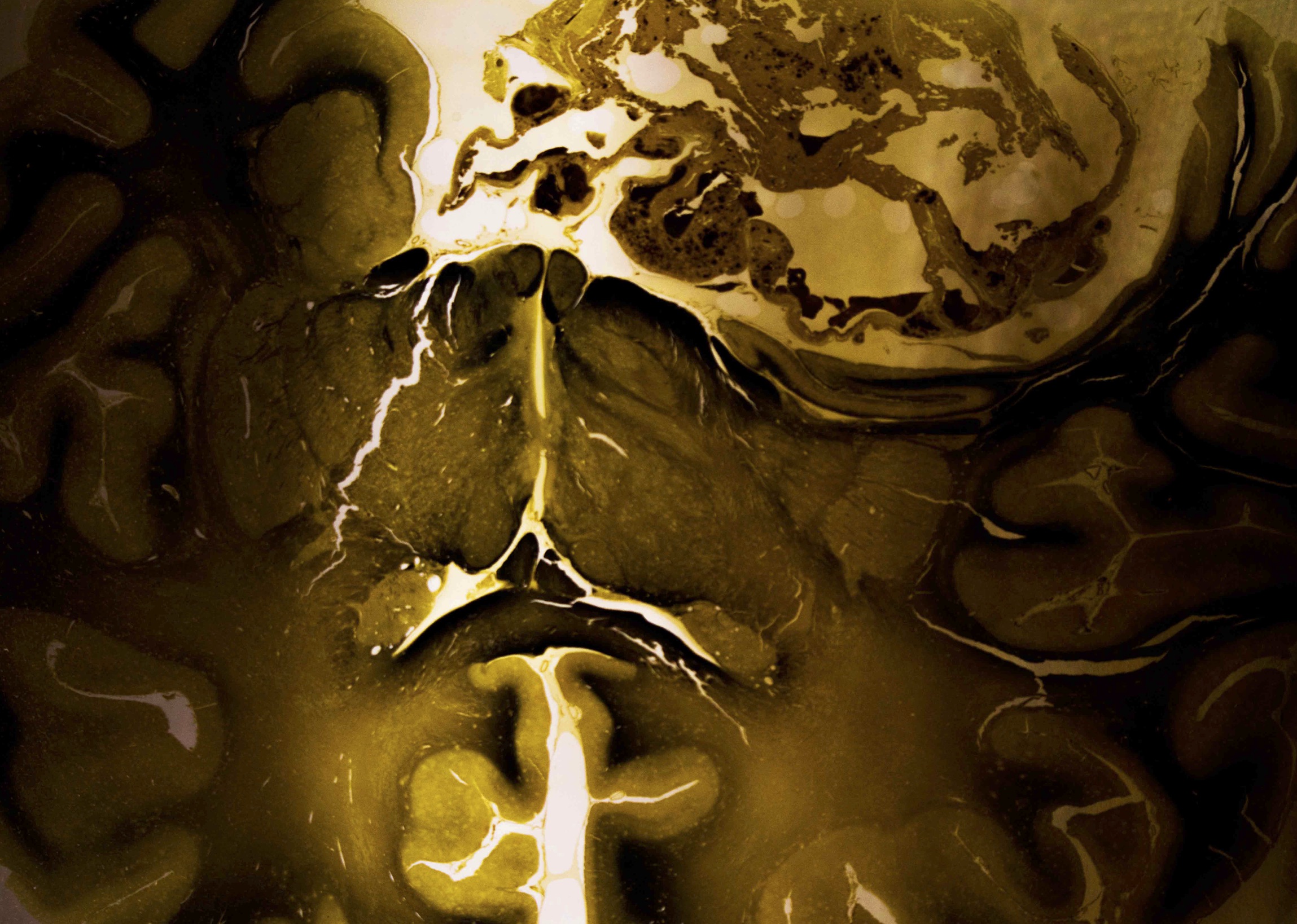
Karen Burgess sits on the floor of her living room, a stretched canvas in her lap. Strings tied to the frame extend to a hook on the drywall behind her, holding her painting-in-progress upright. A loose gray braid drapes over her black sweatshirt. She leans carefully into the canvas and adds short, precise, sky-blue brush strokes. The sky surrounds her pencil sketch of the Eight Auspicious Symbols, a collection of Buddhist images that includes an umbrella, a conch shell, a wheel, and a lotus flower. Lama Tsondru Sangpo, a Buddhist born in Tibet but raised in northern India’s community of Tibetan exiles, squats next to her, peering at her work though small, wire-frame glasses. He wears khakis and a yellow button-down shirt, and a string of prayer beads hangs around his neck. His dark hair, thinning at the temples, sits wrapped into a tiny knot at the crown of his head. Through the room’s window, I watch Tibetan prayer flags wave in the wind, rising above the white clapboard homes of suburban Hamden.
Burgess, an art therapist at a New Haven Hospital, is one of Lama Tsondru Sangpo’s newest students. She joins him in his home for thangka painting classes every Sunday. Thangkas, pronounced ton-kas, are devotional paintings originating in the Himalayas. They are intended to help Buddhists visualize their meditative texts. They are not just depictions of Buddhist deities, but interactive, physical manifestations of the gods themselves; being near the thangkas means being in the presence of the deities, which brings good karma both to the painter and the viewer. Burgess is not Buddhist, but here in Lama Tsondru’s living room, she works under his guidance in what she considers both a spiritual and aesthetic practice. She has crafted a conglomerate religion for herself, incorporating elements of Buddhism as well as other faiths. Thangka painting is one part of that spiritual practice.
Lama Tsondru has been teaching thangka painting classes out of his house since he moved to New Haven in 1999. His students pay a fee of sixty dollars per class. These funds support the Gonjang Samten Choepuk Monastery he started in Rangbull, India back in 1976. With his teaching, he works to maintain an artistic and spiritual tradition.
Recently, the circle of devoted painters has been shrinking, and commercial tourist imitations have proliferated. Lama Tsondru said that many artisans in India and Nepal have chosen to forgo the arduous training process. Some circumvent the recitation of mantras, the meditation, and the consecration that traditionally granted the thangkas their power to bring karmic benefit. Instead, they copy and trace old thangkas, often losing the original proportions of the deities, as written in the texts. These mass-produced thangkas Lama Tsondru sees back at home concern him. “They are really diminishing or destroying our very precious thangka tradition,” he said.

In Lama Tonsdru’s monastery in Rangbull, the small staff and thirteen students spend six years in training, memorizing the Buddhist texts and mantras, the proportions, measurements, and angles with which each deity must be drawn, and practicing their painting technique. Lama Tsondru has exhibited paintings in Connecticut, Massachusetts, and New York. By bringing this threatened art form to the U.S., he intends to partially fund the monastery back home.
Though the paintings his Hamden students produce may not be of the same technical quality as those of his monastery students, he asks that his four American students follow traditional practices. They recite the mantras before they begin painting, and they draw the deities in their correct proportions. They learn to work in a specific order: first the eyes, then the face, then the body. It can take years before a student is ready to begin drawing on canvas. In traditional thangkas, each detail is measured, precisely and geometrically. “Without following the text, without doing the important proportions and measurements, that thangka is not considered like a thangka,” Lama Tsondru said.
Even small errors might invalidate the thangka as a religious object, an embodied artwork. This sometimes causes stress among his Hamden students, who don’t practice their technique as often as his students in India. “Everyone else is doing deities,” Burgess laughs. “I think Lama Tsondru…doesn’t want me to start on a deity and then ruin it.”
***
To begin the class, Lama Tsondru leads students in a mantra to Manjushri, the deity of knowledge and wisdom. Lama Tsondru, sitting cross-legged on the floor, begins to chant in a deep voice, and his two students follow along, reading softly from a transliterated version. Each settles into a spot on his living room floor and begins to paint. He kneels next to Bobby Banquer, a student who has been studying with him for eight years. Lama Tsondru offers quiet corrections, pointing to small modifications that must be made. Banquer brushes her graying bangs away and peers through electric-blue glasses, carefully tapping her brush to the canvas. Banquer, a New Haven local like Burgess, started taking classes eight years ago, after becoming increasingly interested in Asian art through her yoga practice.
Once he finishes correcting Banquer’s small error, the lama pulls out a large black art case and begins flipping through a file of a student’s work. He points out pages filled with precisely proportioned eyes, ink swirls of clouds and folding fabrics, and intricately measured sketches of the face of the Buddha, the body of the Buddha, the bodies of other deities, each measured in its precise geometric proportions. But some, he says, are not quite right. “This face is not so good,” he says, putting two drawings of Tara, a female deity revered for compassion and action, side by side. I can barely tell the difference between the two—the eyes of one deity are slightly more narrow, the breasts more round, the waist more tilted—but Lama Tsondru knows which one is correct. “This one,” he says, pointing to the other. “This one is better, improved.”
***
Out of Lama Tsondru’s four regular students in Hamden, three are Buddhist. Each student aside from Banquer heard about the center through word of mouth and became intrigued by the merging of spiritual and artistic practices. Burgess and Sue MacClain, another student, had both studied art prior to Lama Tsondru’s classes. Initially, they were attracted to the aesthetics of the thangkas, but continued their study for the art’s spiritual aspect. “The actual time spent working on it is very meditative,” said MacClain, who has been studying thangka painting with Lama Tsondru for almost three years. “It’s a way to become really mindful about what you’re doing. You have to be really present, really look, really see, in order to be so precise about it.”
The attention to detail and tradition required to paint thangkas aligns the practice with other elements of Buddhism. In 2007, Lama Tsondru formally founded his own center for Buddhist teaching, called the Thupten Ling Dharma Center. While there are just four students who regularly attend Lama Tsondru’s thangka painting classes, there are now about twenty members of the sangha, the Buddhist term for community of practice. Aside from Lama Tsondru’s wife and children, the majority of the sangha members are Americans, some of whom have been practicing Buddhism for decades, and others who only recently took their commitment vows. Lama Tonsdru does not require his thangka painting students to join the sangha.
Burgess, who is neither a member of the sangha nor a fully practicing Buddhist, values the meditative elements of the disciplined adherence to the rules of thangka painting. “This is my church,” she tells me, referring to the process of painting. She has an altar at home that is “partially Buddhist” though mixing and matching from different religions can get complicated, Burgess believes that if she follows the rules that Lama Tsondru has laid out for her, even her thangka can create good karma. “If it’s done correctly and with the right attitude, it has benefit for whoever looks at it.”
***
Lama Tsondru’s class is much more than a Sunday hobby; the students who come in who listen to his methodical instructions enter a tradition, even while they adapt it to their New Haven routines. The paintings that hang in their homes might not be as perfect as those produced in Rangbull, but even as the practice has crossed overseas, the artisans back in the monastery continue their work. And in Hamden, the students and those who observe their artwork all benefit from the deities conjured on canvas.


